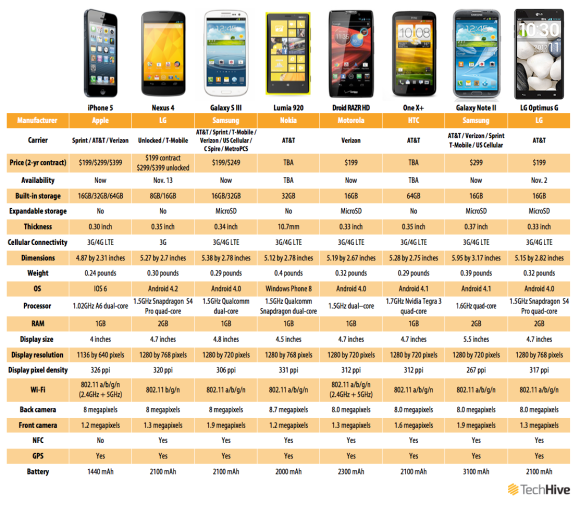The BlackBerry Z10, which is now available for pre-order, is all about its 4.2-inch touchscreen display. Meanwhile, the BlackBerry Q10 fills the hardware keyboard void that's been abandoned by competing phone manufacturers.
Can these two smartphones hold a candle to the phone hardware crowding the market today? If you want to judge, here is a comparison chart of current major smartphones and their specs.
 Daniel Ionsecu
Daniel IonsecuBlackBerry Z10: Great touchscreen
The first thing you'll notice in picking up the Z10 is that it feels light and looks reasonably thin. It weighs 135 grams and stands 9mm thick, which compares favorably to the sleeker-still iPhone 5.It actually looks quite similar to the iPhone 5; the Apple phone stands taller, but is narrower. The near-buttonless design gives the Z10 a more futuristic look. The only buttons are along the right-hand side, volume up and down buttons separated by a hardware mute button (huzzah) in between.
 BlackBerry
BlackBerryThis phone's gesture interface definitely takes some getting used to. I was used to using gestures for the BlackBerry PlayBook but, while there are some echoes of familiarity between that tablet OS and the new BlackBerry 10, there's plenty new in BB10 to get used to.
BlackBerry Hub
I really liked the BlackBerry Hub, both in concept and in my initial use. But I wonder how useful that feature will be in the end when I'm inundated with content from my various social networks.My colleague Tim Moynihan wondered aloud whether you really need all your emails and tweets and incoming content to be in one place. We both liked the quick-action slider that popped out of the right side of the screen though, when long-pressing on a message; the slider gave the various option to act on that contact or message (for example, file it, flag it, forward it, call, text, and the like).
The predictive text did a startlingly good job of suggesting the words you are actually going to type. If you type the letter "W," for example, the word "Would" hovers above the "O," the word "What" hovers above the "H," the word "We" hovers above the "E," and so forth.
By swiping upward over a suggested word, it adds that word to your message. According to BlackBerry, the feature also adapts to your own text input over time; the words it suggests are in line with the words you use the most.
Predictive text: big timesaver
Even without the personalized suggestions, we found that the predictive-text feature (and the way it's implemented) really is a big time-saver for quick messages. Writing a message such as "On the way, I'll be there soon" involves typing a few letters and swiping upward a few times with your thumb instead of writing the whole thing. This keyboard essentially eliminates the need for acronyms and text-speak such as "OTW," "BRB," and "OMG," as typing full words takes much less time than on other phones. BlackBerry
BlackBerryIt actually takes a bit of coordination and muscle memory to switch between tapping letters, swiping upward, and occasionally moving your thumb to see what words it's suggesting.
The predictive-text feature is only a fraction of the story, really. The touchscreen keyboard on the Z10 is probably the best either of us have ever used in terms of autocorrect features and typing accuracy.
When our thumbs flew across the keyboard in landscape orientation, the Z10 did a solid job at making our fast-and-furious touchscreen typing more coherent and accurate than other devices have managed.
Stay tuned for our full review of the Z10.
BlackBerry Q10: Keyboard-a-rific
For all the competitive importance the touchscreen BlackBerry Z10 carriers, the BlackBerry Q10 is the phone that stands out for all kinds of reasons—most noticeably, of course, for its physical keyboard.During my limited time handling the device (truly limited—BlackBerry representatives were very careful about what you could do with the Q10), I found the physical keyboard a welcome return to years past.
 BlackBerry
BlackBerryThe buttons are three percent larger than those on a 2011 BlackBerry 9900, while the keyboard itself is situated in a straight design, without the angling found on the 9900.
The 3.1-inch display packs 330 pixels per inch, and has a resolution of 720 by 720 pixels. The SuperAMOLED display is 30 percent larger than on the BlackBerry Bold 9900, and looked bright and crisp in the demos.
Of the two phones, I have to admit that the Q10 is the one I more looked forward to playing with extensively. Sadly, that will have to wait until later this spring.
Sign up here with your email
ConversionConversion EmoticonEmoticon